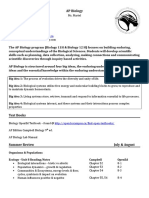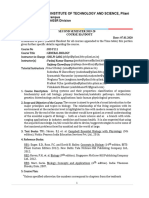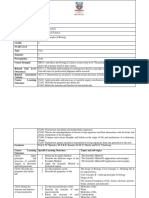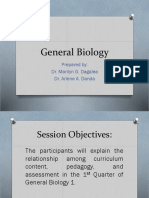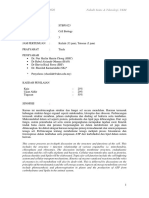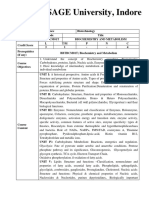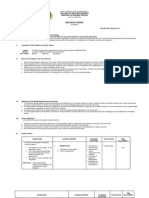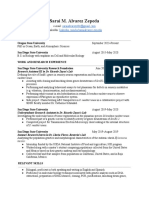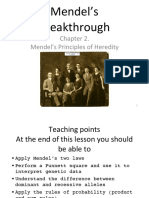Professional Documents
Culture Documents
Birla Institute of Technology and Science, Pilani Pilani Campus Academic - Undergraduate Studies Division (AUGSD)
Birla Institute of Technology and Science, Pilani Pilani Campus Academic - Undergraduate Studies Division (AUGSD)
Uploaded by
shiv mishraOriginal Description:
Original Title
Copyright
Available Formats
Share this document
Did you find this document useful?
Is this content inappropriate?
Report this DocumentCopyright:
Available Formats
Birla Institute of Technology and Science, Pilani Pilani Campus Academic - Undergraduate Studies Division (AUGSD)
Birla Institute of Technology and Science, Pilani Pilani Campus Academic - Undergraduate Studies Division (AUGSD)
Uploaded by
shiv mishraCopyright:
Available Formats
BIRLA INSTITUTE OF TECHNOLOGY AND SCIENCE, Pilani
Pilani Campus
Academic – Undergraduate Studies Division (AUGSD)
Second Semester 2021-22 (Old Academic Schedule)
Course Handout – Part II
Date: 11th March 2022
In addition to Part-I (General Handout for all courses) printed on page 1 of the timetable book; this
portion gives further specific details regarding the course.
Course Number : BIO F111
Course Title : GENERAL BIOLOGY
Instructor-in-Charge : Rita Sharma ([email protected])
Instructors: Pankaj Kumar Sharma ([email protected])
Shilpi Garg ([email protected])
Tutorial Instructor/s: Balakumaran Chandrasekar ([email protected])
P.R. Deepa ([email protected])
B. Vani ([email protected])
1. Course Description:
Living systems and their properties; biochemistry and cell biology; primary biochemical/ metabolic
pathways; introductory genetics; biotechnology and its applications; basic human physiological
processes. These topics will be taught using an integrated approach – by interlacing concepts at the
cellular level with those that happen at the organ system level.
2. Scope and Objective of the Course:
The course is aimed to provide a broad introduction to the major principles and topics in biology.
The relationship of the living organism with its environment at the molecular level is highlighted in
line with modern research in biological sciences. By the end of the course, the student would have
gained an overall understanding of the core biological principles and wide-ranging applications of
biology in industry, medicine and human health.
3. Textbook:
Simon, E.J. et. al. Campbell Essential Biology with Physiology (5th edition). Noida: Pearson India
Education Services Pvt. Ltd., 2016.
4. Reference Books:
RB1: Enger, E.D., Ross, F.C. and David B. Bailey. Concepts in Biology (14th edition, BITS-Pilani
Custom Edition 2012). New Delhi: Tata McGraw-Hill Publishing Company Ltd., 2012.
RB2: Raven, P.H., et. al. Biology (9th edition). Singapore: McGraw-Hill Publishing Company Ltd.,
2012.
5. Course Plan:
*Unless specified otherwise, the numbers correspond to chapters from the textbook
Please Do Not Print Unless Necessary
BIRLA INSTITUTE OF TECHNOLOGY AND SCIENCE, Pilani
Pilani Campus
Academic – Undergraduate Studies Division (AUGSD)
Lect. Learning Chap./ Learning Outcomes
Topics to be covered
# Objectives Ref #*
Get the initial big picture
Getting Orientation to the course
1 about studying biology
introduced to content; the scientific method; 1, 4
and aspects of
the course properties of life
bioengineering
Develop an appreciation
1 Scientific Study Science and Theories in Science for scientific methods
1
of Life and Classification and the taxonomic
classification system
Differentiate between
Organic Building blocks; proteins
2-4 structure and properties
chemistry of (including enzymes); 3, 5
of biological
living things carbohydrates; lipids
macromolecules
Cell theory; prokaryotic and Associate organelles
5-6 Cell Structure eukaryotic cells; brief overview with their cellular
4
and Function of cellular organelles; membrane functions
transport mechanisms
Biochemical Pathways – Cellular Examine the steps the
Obtaining
7-8 respiration: three stages of cells use to derive
nutrition: 6
generating ATPs; process of energy from different
cellular level
fermentation biomolecule classes
Borrowing Examine the steps the
Biochemical Pathways –
energy from plant cells employ to
9 Photosynthesis: light reactions,
nature: 7 synthesize sugars using
Calvin cycle; autotrophs and
photosynthetic sunlight
heterotrophs
reactions
Comprehend the types
Cell cycle and Mitosis; stages of
Cell Division – of cell division and the
mitosis; cancer and cell cycle;
10-12 Proliferation underlying control
Meiosis – stages and generation 8
and checkpoints; compare
of genetic diversity;
Reproduction the differing mechanics
chromosomal abnormalities
in cancer cells
Mendelian genetics – laws of 9+ Apply the famous
13-15 Patterns of Mendelian laws to solve
heredity; extensions to Mendel; RB1:
Inheritance problems in heredity
other influences on phenotype 10
16 Nucleic Acid Appreciating the process
DNA structure and it's discovery 10
Structure to discovery of DNA
Please Do Not Print Unless Necessary
BIRLA INSTITUTE OF TECHNOLOGY AND SCIENCE, Pilani
Pilani Campus
Academic – Undergraduate Studies Division (AUGSD)
Analyze in detail the
Replication; RNA and protein
17-20 DNA and RNA – processes associated
synthesis: transcription and 10
Function with the Central Dogma
translation; mutations
of Biology
Genetic How and why genes are Understand the
21-23 regulation and controlled; cloning plants and importance of regulation
11
the process of animals; stem cells ; the genetic of gene expression
cloning basis of cancer
Techniques of DNA Critique the use of
Biotechnology manipulation; GMOs; DNA biotechnology tools for
24-26
and its Fingerprinting; bioinformatics; 12 societal benefit
Applications forensic science; biotechnology
ethics
Unifying Learn about the perfect
Regulating internal body
Concepts of control mechanisms that
27-30 environment; Human 13, 14,
Animal ensure homeostasis in
circulatory, respiratory, 15
Structure and the human body
digestive and excretory systems
Function
Understand how life-
Organization of the nervous
sustaining messages get
31-32 Nervous system; nerve signal
19 transmitted in the
System transmission; central and
human body via
peripheral nervous systems
electrical signals
Compare the types of
33-34 Body’s defense Innate immunity; lymphatic defense mechanisms
16
strategies system; adaptive immunity operating in the body
when faced by diseases
Understand and
appreciate how life-
Different hormones, their
35 Hormonal sustaining messages get
production sites, and modes of 17
system transmitted in the
action
human body via
chemical signals
Human Reproduction, Sex and Develop a scientific
Human Sexuality - gametogenesis; male 18+ awareness about
36-
reproduction and female reproductive RB1: reproductive health
37
and embryonic systems – hormonal controls; 27
development pregnancy and early human
development
Note: A few topics may be given for self-study, if deemed appropriate by the instructor team.
6. Evaluation Scheme:
_
Please Do Not Print Unless Necessary
BIRLA INSTITUTE OF TECHNOLOGY AND SCIENCE, Pilani
Pilani Campus
Academic – Undergraduate Studies Division (AUGSD)
Evaluation Nature of
# Duration Weightage % Max Marks Date and Time
component Component
Mid-semester Closed-book
1 90 min 25% 50 TBA
Test type
Closed-book
2 Course Quiz 40 min 20% 40 TBA
type
Take Home/In
Class
Open/Closed-
3 Assignments and Variable 10% 20 TBA
book type
Class
Participation
Comprehensive Open/Closed-
4 3 hours 45% 90 22/06
Examination book type
7. Academic Conduct Policy:
It is expected that all students follow the highest standard of academic practice when participating
in any evaluation component. Plagiarism material of any sort in evaluation components will dealt
strictly and any such misconduct in this line will likely lead to awarding of no marks for such
evaluation component. Having a zero-tolerance for academic dishonesty, any case of misconduct,
however minor, will be dealt appropriately.
8. Grading Policy:
Award of grades would be guided by the histogram of marks and course average. If a student
absents himself/herself in any component (listed in the Evaluation Scheme), his/her performance
in the course may be reported as ‘NC’ (Not Cleared).
9. Make-up Policy:
If a student miss any of the evaluation components due to a genuine reason (serious medical causes
leading to hospitalization, personal/family emergencies) there exists a provision to apply for make-
up. Please note that one cannot apply for a make-up if you have already taken the evaluation
component. Prior permission must be taken from the Instructor-in-Charge whenever possible,
before applying; otherwise, he must be informed at the earliest after missing the component. Due
to the nature of the component, granting make-up for activities that are held in lecture/tutorial
classes may not be possible. Whether to grant a make-up or not is decided by the Instructor-in
Charge (in consultation with the team) and shall be final. No make-up would be considered for
Course Quizzes and Assignments.
10. Instructor Consultation: For any assistance in the course and clarifications, students can set up a
meeting with the instructors by sending an email. The instructors may announce a time when they
would be available online/offline every week for meeting without appointment.
Please Do Not Print Unless Necessary
BIRLA INSTITUTE OF TECHNOLOGY AND SCIENCE, Pilani
Pilani Campus
Academic – Undergraduate Studies Division (AUGSD)
11. Course Announcements and Communications:
All major announcements will be made via email sent to the official student account (BITS email).
Instructors may be contacted by email, or by phone (if the instructor permits you to do so). When
sending emails or replying to instructors, students are expected to follow proper etiquette – being
prompt in replying to emails, always beginning by addressing the instructor, stating the course and
the context, and keeping the content brief and crisp.
(Team, BIOF111)
Please Do Not Print Unless Necessary
You might also like
- High School Biology: Comprehensive Content for Cell & Molecular BiologyFrom EverandHigh School Biology: Comprehensive Content for Cell & Molecular BiologyNoch keine Bewertungen
- Cell and Molecular Biology Module (Lecture and Laboratory)Document200 pagesCell and Molecular Biology Module (Lecture and Laboratory)RM Montemayor100% (2)
- Lecture Notes in Biochemistry MidtermDocument57 pagesLecture Notes in Biochemistry MidtermROQUE SERENAS67% (3)
- Ap Biology Course Outline 2017Document5 pagesAp Biology Course Outline 2017api-323183567Noch keine Bewertungen
- CS444: BIO INFORMATICS (Lab 1 - Manual) Bioinformatics Databases and Key Online ResourcesDocument2 pagesCS444: BIO INFORMATICS (Lab 1 - Manual) Bioinformatics Databases and Key Online ResourcesSUNDAS FATIMANoch keine Bewertungen
- Biological Approach EssayDocument1 pageBiological Approach EssayBenjamin JohnNoch keine Bewertungen
- Bio F111 1002Document5 pagesBio F111 1002ABHITH KRISHNANoch keine Bewertungen
- Bio f111 BiologyDocument5 pagesBio f111 Biologyavriolopes1308Noch keine Bewertungen
- Bio F111 1002 20230809235550Document4 pagesBio F111 1002 20230809235550Fighting CucumberNoch keine Bewertungen
- Bio F111 1002Document4 pagesBio F111 1002ANoch keine Bewertungen
- Birla Institute of Technology and Science, Pilani Pilani Campus Academic - Undergraduate Studies Division (AUGSD)Document5 pagesBirla Institute of Technology and Science, Pilani Pilani Campus Academic - Undergraduate Studies Division (AUGSD)AmanNoch keine Bewertungen
- Course OutlineDocument3 pagesCourse OutlinebkrmnbxbjtNoch keine Bewertungen
- BIO F111 General Biology I Sem 23-24 HODocument3 pagesBIO F111 General Biology I Sem 23-24 HOobettajohnson6Noch keine Bewertungen
- Gen Bio PDFDocument6 pagesGen Bio PDFAbsolute ZeroNoch keine Bewertungen
- Course OutlinesDocument15 pagesCourse Outlinessyed bharathNoch keine Bewertungen
- BIO111 Principles of Biology Course Outline 2022Document5 pagesBIO111 Principles of Biology Course Outline 2022Resego lentsweNoch keine Bewertungen
- Simplified Course Pack (SCP) For Self-Directred Learning: Physically Detached Yet Academically AttachedDocument6 pagesSimplified Course Pack (SCP) For Self-Directred Learning: Physically Detached Yet Academically AttachedLeah Mariz RocaNoch keine Bewertungen
- Course Outline FUNCORE 102 General Zoology 1st Sem 2022-2023Document5 pagesCourse Outline FUNCORE 102 General Zoology 1st Sem 2022-2023Gracia NicolaiNoch keine Bewertungen
- Biology 1 and 2 K12Document12 pagesBiology 1 and 2 K12ewwwNoch keine Bewertungen
- BIO 1203 Course SyllabusDocument4 pagesBIO 1203 Course SyllabusAriful IslamNoch keine Bewertungen
- SINOPSIS CELL BIOLOGY Ifolio S2 20192020 PINDAAN COVID PDFDocument5 pagesSINOPSIS CELL BIOLOGY Ifolio S2 20192020 PINDAAN COVID PDFAzzwa ZubairiNoch keine Bewertungen
- Syllabus MSC ZoologyDocument156 pagesSyllabus MSC ZoologyAnkit SinghNoch keine Bewertungen
- Biology Midyear SyllabusDocument11 pagesBiology Midyear SyllabusPete Gabriel LedesmaNoch keine Bewertungen
- Curriculum Pacing Guide For Grade 8 in Science IIDocument28 pagesCurriculum Pacing Guide For Grade 8 in Science IIDon King EvangelistaNoch keine Bewertungen
- B.Sc. Biotechnology Syllabus Final PDFDocument63 pagesB.Sc. Biotechnology Syllabus Final PDFdeepakNoch keine Bewertungen
- Lesson Plan For C.O. 2-1Document2 pagesLesson Plan For C.O. 2-1Jubilee BundaNoch keine Bewertungen
- Syllabus Bioquímica 2021-II FG YACHAYDocument8 pagesSyllabus Bioquímica 2021-II FG YACHAYMathew Cedeño AvellanNoch keine Bewertungen
- NUR 102 - Human Anatomy and Physiology Rev. 001Document12 pagesNUR 102 - Human Anatomy and Physiology Rev. 001Alan0% (2)
- Navotas Polytechnic CollegeDocument3 pagesNavotas Polytechnic CollegeLOUIE BoquilaNoch keine Bewertungen
- Profile Agroalimentary Technology and Viticulture - OenologyDocument11 pagesProfile Agroalimentary Technology and Viticulture - OenologyLina MarkuNoch keine Bewertungen
- BCP2123 Biochemistry Module GuideDocument5 pagesBCP2123 Biochemistry Module Guideronwest1990Noch keine Bewertungen
- 4bot111 Notes - 2023Document106 pages4bot111 Notes - 2023yanelisajeke6Noch keine Bewertungen
- Bchet-149 eDocument382 pagesBchet-149 eAakash JhaNoch keine Bewertungen
- Bio 2Document3 pagesBio 2ESCOTE LeandroNoch keine Bewertungen
- Biochem Lec Syllabus 2023 2024 UddDocument11 pagesBiochem Lec Syllabus 2023 2024 Uddmollycule.cutieNoch keine Bewertungen
- Biochemistry CoursepackDocument34 pagesBiochemistry Coursepackanonymous squash0% (1)
- (Applicable From The Academic Session 2018-2019) : Basic Knowledge of Physics, Chemistry and MathematicsDocument4 pages(Applicable From The Academic Session 2018-2019) : Basic Knowledge of Physics, Chemistry and MathematicskaiserrichhiNoch keine Bewertungen
- Biotech 2021Document473 pagesBiotech 2021VornameNoch keine Bewertungen
- T.Y.B SC Sem 5 Microbiology SyllabusDocument40 pagesT.Y.B SC Sem 5 Microbiology SyllabusAditi RaiNoch keine Bewertungen
- Annual Plan For Grade 11 Academic Year 2010 EDocument3 pagesAnnual Plan For Grade 11 Academic Year 2010 EZemetu Gimjaw Alemu100% (4)
- Bio 14 Spring 2021 SyllabusDocument10 pagesBio 14 Spring 2021 SyllabusSayeda JobaNoch keine Bewertungen
- Biology AS Term 1 PlanDocument4 pagesBiology AS Term 1 PlanSarah-Jane RogersNoch keine Bewertungen
- TLP ABB T 101 1 Sem Fundamentalof Plant Biochemistry and BiotechnologyDocument11 pagesTLP ABB T 101 1 Sem Fundamentalof Plant Biochemistry and BiotechnologyArya GhangaleNoch keine Bewertungen
- Birla Institute of Technology and Science, Pilani: Hyderabad CampusDocument3 pagesBirla Institute of Technology and Science, Pilani: Hyderabad CampuspranavjibhakateNoch keine Bewertungen
- Biomedical Science 1ABCDocument2 pagesBiomedical Science 1ABCkennethNoch keine Bewertungen
- DSKP BIO (English)Document85 pagesDSKP BIO (English)SARANoch keine Bewertungen
- Bio 103Document3 pagesBio 103Idc RoseNoch keine Bewertungen
- Microbiology: Catalan (Cat) Escarlata - Rodriguez@uab - Cat Escarlata Rodriguez CarmonaDocument9 pagesMicrobiology: Catalan (Cat) Escarlata - Rodriguez@uab - Cat Escarlata Rodriguez CarmonaNeils ArenósNoch keine Bewertungen
- MSC Biotechnology Syllabus FINALDocument53 pagesMSC Biotechnology Syllabus FINALdeepakNoch keine Bewertungen
- Double Majors TYBSc Biochemistry-Zoology - 2019-2020Document58 pagesDouble Majors TYBSc Biochemistry-Zoology - 2019-2020Meir SabooNoch keine Bewertungen
- Molecular Basis of Disease CourseDocument21 pagesMolecular Basis of Disease CourseImranNoch keine Bewertungen
- Introductory Biology FOR Engineers 3-0-2 4.0 SBL100: Course TemplateDocument4 pagesIntroductory Biology FOR Engineers 3-0-2 4.0 SBL100: Course TemplateGulrez MNoch keine Bewertungen
- Cell Bio Syllabus 2011Document13 pagesCell Bio Syllabus 2011InuyashayahooNoch keine Bewertungen
- Program Biochemistry MDDocument7 pagesProgram Biochemistry MDMohamed MounirNoch keine Bewertungen
- PMC MDCAT Syllabus 2021 - FinalDocument46 pagesPMC MDCAT Syllabus 2021 - FinalbilalNoch keine Bewertungen
- Scope and Sequence: Inspire BiologyDocument2 pagesScope and Sequence: Inspire Biologyjsencion977Noch keine Bewertungen
- B.Tech 3rd SemDocument23 pagesB.Tech 3rd Semshahima284Noch keine Bewertungen
- Biochem COURSE SYLLABUSDocument10 pagesBiochem COURSE SYLLABUSSharmaine DurangoNoch keine Bewertungen
- Offered: Nalinik@sebs - Rutgers.eduDocument5 pagesOffered: Nalinik@sebs - Rutgers.edubethajaquelyn553Noch keine Bewertungen
- CM Gen. Bio 2Document14 pagesCM Gen. Bio 2Georgette MatinNoch keine Bewertungen
- Practice Makes Perfect: Biology Review and Workbook, Third EditionFrom EverandPractice Makes Perfect: Biology Review and Workbook, Third EditionNoch keine Bewertungen
- Course Code Part Sem Paper Code Paper NameDocument3 pagesCourse Code Part Sem Paper Code Paper Nameshiv mishraNoch keine Bewertungen
- Shaheed Bhagat Singh Evening College Enrolment Number All Courses (2017)Document16 pagesShaheed Bhagat Singh Evening College Enrolment Number All Courses (2017)shiv mishraNoch keine Bewertungen
- Sr. No. Paper Type Part Sem Paper Code Paper NameDocument7 pagesSr. No. Paper Type Part Sem Paper Code Paper Nameshiv mishraNoch keine Bewertungen
- Shaheed Bhagat Singh (Eve.) College: Certificate To Be Submitted by The PensionerDocument2 pagesShaheed Bhagat Singh (Eve.) College: Certificate To Be Submitted by The Pensionershiv mishraNoch keine Bewertungen
- Shaheed Bhagat Singh (Evening) CollegeDocument1 pageShaheed Bhagat Singh (Evening) Collegeshiv mishraNoch keine Bewertungen
- 3 Floors in One BuildingDocument104 pages3 Floors in One Buildingshiv mishraNoch keine Bewertungen
- In Spermatogenesis, 4 Genetically Unique Sperm Cells Are Created. in Oogenesis, 1 Ovum Forms and 3 Polar BodiesDocument1 pageIn Spermatogenesis, 4 Genetically Unique Sperm Cells Are Created. in Oogenesis, 1 Ovum Forms and 3 Polar Bodiesscooter brewerNoch keine Bewertungen
- Accomplishment AubreyDocument2 pagesAccomplishment AubreyAubrey GadorNoch keine Bewertungen
- BiodiversityDocument73 pagesBiodiversityNila FirmaliaNoch keine Bewertungen
- Medical GeneticsDocument4 pagesMedical GeneticsCpopNoch keine Bewertungen
- BSC BioinformaticsDocument31 pagesBSC BioinformaticsAjay KumarNoch keine Bewertungen
- Bio Revision Questions 4Document6 pagesBio Revision Questions 4Ryan SamuelNoch keine Bewertungen
- Science 9 Q1 Mod3 Non Mendelian Patterns of InheritanceDocument32 pagesScience 9 Q1 Mod3 Non Mendelian Patterns of InheritanceSkyeNoch keine Bewertungen
- Sarai M. Alvarez Zepeda: E-Mail: LinkedinDocument4 pagesSarai M. Alvarez Zepeda: E-Mail: Linkedinapi-676558382Noch keine Bewertungen
- 2 5 9-Genetic-EngineeringDocument42 pages2 5 9-Genetic-EngineeringsoffiahNoch keine Bewertungen
- 7e's Lesson-Plan Grade 10 - OJT 7 - Types of Gene MutationDocument7 pages7e's Lesson-Plan Grade 10 - OJT 7 - Types of Gene MutationDennard LomugdangNoch keine Bewertungen
- MCB 251 Lab PCRDocument8 pagesMCB 251 Lab PCRDan BorsNoch keine Bewertungen
- Molecular Basis of Inheritance: DNA: Structure of Polynucleotide ChainDocument25 pagesMolecular Basis of Inheritance: DNA: Structure of Polynucleotide ChainYashwanth SrinivasaNoch keine Bewertungen
- Fact Sheet 6 - Genetic Counselling: Page 1 of 2 WWW - Genetics.edu - Au Updated 15 June 2016Document2 pagesFact Sheet 6 - Genetic Counselling: Page 1 of 2 WWW - Genetics.edu - Au Updated 15 June 2016Yuliandini Pangestika WiyonoNoch keine Bewertungen
- Lesson 14 Genetic InterventionDocument11 pagesLesson 14 Genetic InterventionOliver SantosNoch keine Bewertungen
- Asokan Et Al 2015 - Coi in IndiaDocument4 pagesAsokan Et Al 2015 - Coi in Indiafosudavid.jfNoch keine Bewertungen
- Snake EvolutionDocument22 pagesSnake EvolutionJoshua LuNoch keine Bewertungen
- The Human Genome Diversity ProjectDocument225 pagesThe Human Genome Diversity Projectabdur2009100% (1)
- Asexual and Sexual Reproduction Lesson ElementDocument10 pagesAsexual and Sexual Reproduction Lesson ElementAbir OmarNoch keine Bewertungen
- Dna Model Rubric: Level of ProficiencyDocument1 pageDna Model Rubric: Level of ProficiencyMichelle BaguioNoch keine Bewertungen
- Chapter 2. Mendel's Principles of HeredityDocument79 pagesChapter 2. Mendel's Principles of HeredityAlyanna Elisse VergaraNoch keine Bewertungen
- DNA and RNADocument35 pagesDNA and RNAalchristian tomatomNoch keine Bewertungen
- Function: Polytene Chromosomes Are Large Chromosomes Which Have Thousands of DNA Strands. TheyDocument3 pagesFunction: Polytene Chromosomes Are Large Chromosomes Which Have Thousands of DNA Strands. TheyAlmira JaluagNoch keine Bewertungen
- Breeding Aesthetic Objects: Art and Artificial Evolution: Mitchell WhitelawDocument6 pagesBreeding Aesthetic Objects: Art and Artificial Evolution: Mitchell WhitelawAnonymous CjcDVK54Noch keine Bewertungen
- PCR Mori ReviewDocument15 pagesPCR Mori ReviewRay MrinalNoch keine Bewertungen
- Forensic - Shaan KumarDocument15 pagesForensic - Shaan KumarKrishna KumarNoch keine Bewertungen
- 2020 Chapter Lung Cancer and Tobacco Smoking FinalDocument21 pages2020 Chapter Lung Cancer and Tobacco Smoking FinalMarco MerazNoch keine Bewertungen
- Graduate Syllabus For Genetic EngineeringDocument3 pagesGraduate Syllabus For Genetic EngineeringAnuj SharmaNoch keine Bewertungen
- Biology Grade 12 Unit One (Microbiology)Document12 pagesBiology Grade 12 Unit One (Microbiology)Feven AsefaNoch keine Bewertungen



